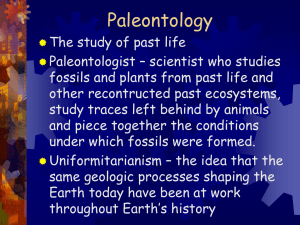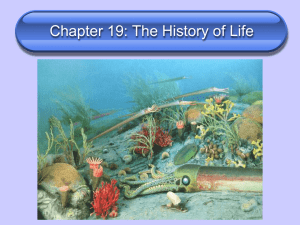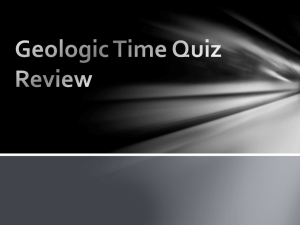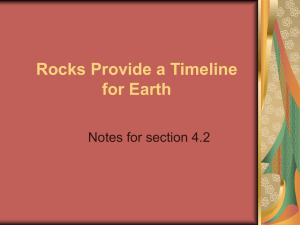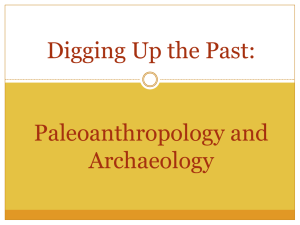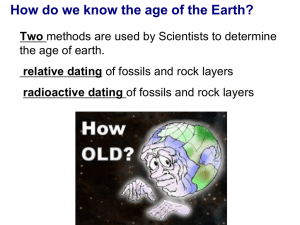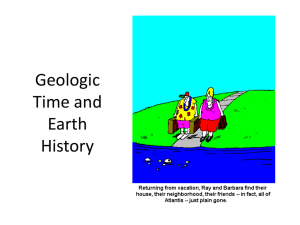The Age of Earth
advertisement
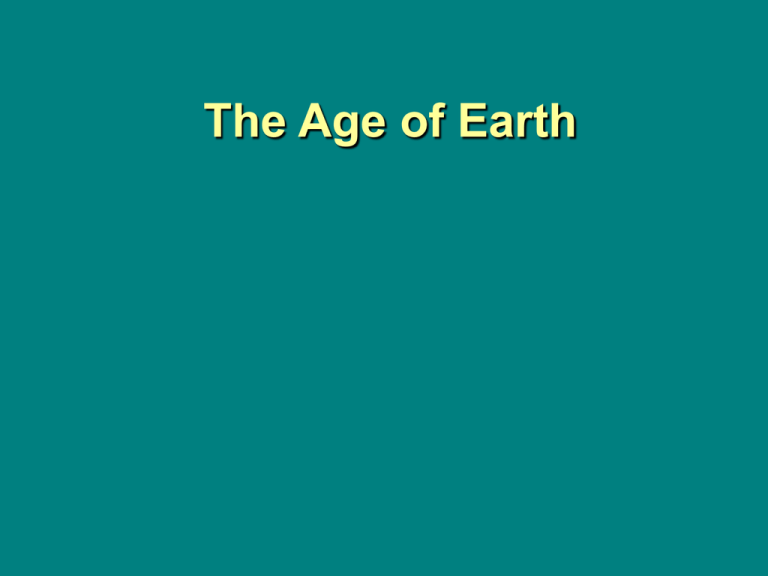
The Age of Earth Classification Quick Quiz Write the letter of the correct definition below the number of the correct corresponding term. Remember to write your name on your paper before you submit your answer sheet. The crime? The Crime? Fossil Evidence Two Types: •Sedimentary – organisms that have died, been covered with sediment and then decomposed. •Whole - When an organism is covered whole in amber and semi preserved. Sedimentary Fossils Amber Fossils What Stories do Fossils Reveal? What Fossils Can Reveal – The fossil record contains an enormous amount of information for paleontologists, researchers who study fossils to learn about ancient life. – By comparing body structures in fossils to body structures in living organisms, researchers can infer evolutionary relationships. – Bone structure and trace fossils, like footprints, indicate how animals moved. – When different kinds of fossils are found together, researchers can sometimes reconstruct entire ancient ecosystems. TIME PLAYS A BIG FACTOR HERE Dating Earth’s History • How do we date events in Earth’s history? Dating Earth’s History • How do we date events in Earth’s history? •Relative dating allows paleontologists to determine whether a fossil is older or younger than other fossils. •Radiometric dating uses the proportion of radioactive to non-reactive isotopes to calculate the age of a sample. Relative Dating – Lower layers of sedimentary rock, and fossils they contain, are generally older than upper layers. – Relative dating places rock layers and their fossils into a temporal sequence. Radiometric Dating – Relative dating is important, but provides no information about a fossil’s absolute age in years. – One way to date rocks and fossils is radiometric dating. – Radiometric dating relies on radioactive isotopes, which decay, or break down, into non-radioactive isotopes at a steady rate. – Radiometric dating compares the amount of radioactive to non-reactive isotopes in a sample to determine its age. – A half-life is the time required for half of the radioactive atoms in a sample to decay. Radiometric Dating – The half-life of potassium-40 is 1.26 billion years. Radiometric Dating – Carbon-14, which has a short half-life, can be used to directly date very young fossils. – Elements with long half-lives can be used to indirectly date older fossils by dating nearby rock layers, or the rock layers in which they are found. Geologic Time Scale – How was the geologic time scale established, and what are its major divisions? – The geologic time scale is based on both relative and absolute dating. The major divisions of the geologic time scale are eons, eras, and periods. Geologic Time Scale – Geologists and paleontologists have built a time line of Earth’s history called the geologic time scale. – The basic divisions of the geologic time scale are eons, eras, and periods. Naming the Divisions – The Precambrian actually covers about 90 percent of Earth’s history. – In this figure, the history of Earth is depicted as a 24-hour clock. Notice the relative length of Precambrian Time—almost 22 hours. Life on a Changing Planet How have our planet’s environment and living things affected each other to shape the history of life on Earth? Life on a Changing Planet – How have our planet’s environment and living things affected each other to shape the history of life on Earth? – Building mountains, opening coastlines, changing climates, and geological forces have altered habitats of living organisms repeatedly throughout Earth’s history. In turn, the actions of living organisms over time have changed conditions in the land, water, and atmosphere of planet Earth. Physical Forces Climate and Temperature – “Heat wave” of the Mesozoic Era, Earth’s average temperatures were only 6°C to 12°C higher than they were during the twentieth century. – During the ice ages, world temperatures were only about 5°C cooler than they are now. – These relatively small temperature shifts changed the shape of life on Earth. Physical Forces – Geological forces have transformed life on Earth, producing new mountain ranges and moving continents. – Volcanic forces have altered landscapes and even formed entire islands. – Local climates are shaped by the interaction of wind and ocean currents with geological features such as mountains and islands. Physical Forces – The theory of plate tectonics explains how solid continental “plates” move slowly above Earth’s molten core—a process called continental drift. – Over the long term, continents have collided to form “supercontinents.” Later, these supercontinents have split apart and reformed. Biological Forces – The activities of organisms have affected global environments. – For example, Earth’s early oceans contained large amounts of soluble iron and little oxygen. – During the Proterozoic Eon, however, photosynthetic organisms produced oxygen gas and also removed large amounts of carbon dioxide from the atmosphere. – The removal of carbon dioxide reduced the greenhouse effect and cooled the globe. The iron content of the oceans fell as iron ions reacted with oxygen to form solid deposits. Previous Slide Back to the Beginning

